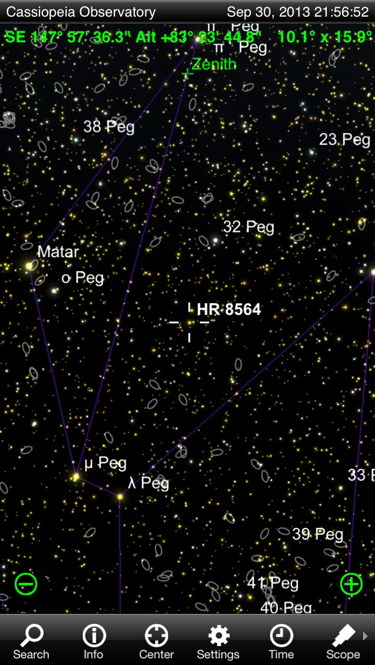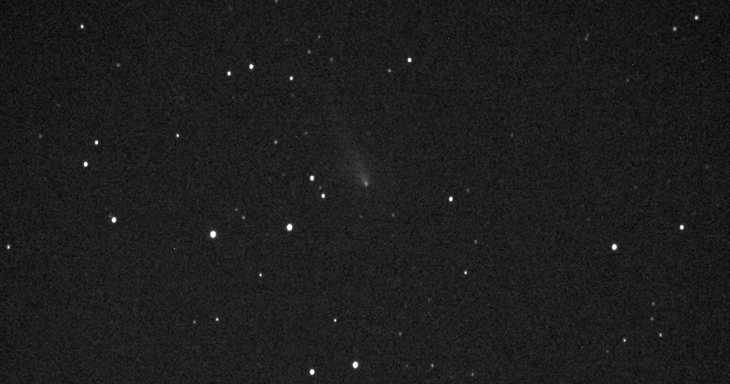
Long Session: NGC254 Galaxy, Critters, Jupiter, Moon,
Comet C/2012 S1 ISON
Posted: 1 October 2013
The observatory was opened on Monday, 30 September 2013, at 1819 MST, 87°F. The sky was clear. The sun had set shortly before the observatory was opened. Beginning at 1826 MST, viewed Saturn and Venus, 83X, 133X, and 222X. Although both planets were too low for good viewing, 133X provided the best views. Cassini Division in Saturn's Ring System was occasionally seen.
Since this was planned to be a long session, I set up a folding recliner chair on the observatory patio. At 1848 MST, Saturn's moon Titan was visible using 83X. At 1853 MST, ended planet viewing (too low in the sky) and slewed to M22 (globular cluster). It was visible at 83X against the still twilight-lit sky. I then went out to the patio and "watched the stars come out". I had the 2X nightscope with me. 1912-1915 MST, watched a satellite pass through the nightscope. I could see the satellite in the nightscope well after it had disappeared from naked eye view.
At 1917 MST, I returned to the observatory and viewed M22. It was a good view at 83X. It was even nice at 222X. I then viewed the globular clusters M13 and M92 at 222X. I then did some beta testing of an app on the iPhone 5s. At 2001 MST, viewed M57 (Ring Nebula), 222X. Nice. Next, I set up the D7000 DSLR for DSO imaging a little later. Having completed that at 1932 MST, I viewed M27 (Dumbbell Nebula), 222X. It was really too faint for that much magnification on the 8" telescope, so switched to 133X. That was a good view. I then viewed M13, M92, and M57 at 133X; all nice views. Epsilon Lyrae (the "Double Double" Star) was viewed at 133X. The components were nicely separated. Also viewed the double star Albireo, 133X. Pretty. M22 was also viewed at 133X. I slewed the 8" telescope to the Andromeda Galaxy and using 133X viewed M31, M32, and M110. Nice views.
I went to the patio at 2050 MST and enjoyed looking at the night sky. I used the nightscope to view M31 (always a nice view in a nightscope) and M45 (the Pleiades). I returned to the observatory at 2133 MST.
At 2135 MST, the telescope was slewed to NGC254 (small faint galaxy), but it was too low to be seen at 83X. It would be this night's DSO imaging target. I enabled "High Precision" GOTO on the telescope for use when imaging. At 2142 MST, the galaxy was faintly visible with averted vision, 83X. I returned to the patio. I did a sky darkness check at 2200 MST. My old eyes could see HR8564 in Pegasus, Magnitude +5.76, near the zenith. These screen shots are from SkySafari Pro on the iPhone 5s:


I had last done a dark sky magnitude check a couple of years ago and reported greater than +7. Whether the reduction is due to increasing light pollution, age, or both, I don't know. But I'm still pretty happy with nearly Magnitude +6 skies.
At 2211 MST, I returned to the observatory. NGC254 was now more easily seen as a faint fuzzy dot. At 2220 MST, I began setting up for prime focus imaging with the D7000 DSLR. Did a focus test on Fomalhaut using the Bahtinov Mask. Slewed to NGC254 and located a faint guide star. Did a framing test exposure (1 minute, ISO 6400, unguided) at 2250 MST, followed by 10 minute and 5 minute guided exposures. This is the 10 minute exposure:

Completed prime focus imaging at 2317 MST. Viewed NGC254, 83X. I then went out to the patio to take a short rest. Just as I sat down on the recliner I heard an animal snorting very near me. Since I had the nightscope with me, I began searching for the animal. I finally saw two Javelina walking around about 50' from me. I continued to watch them and got to see a baby Javelina. (By the way, Javelina is a protected species in Arizona. They are a wild pig.) Since Javelina can be somewhat nasty, especially if they think their young are in danger, I returned to the observatory to continue watching them with the nightscope. A little later I saw both parents and TWO babies. Neat. One of the parents and baby approached the observatory to within about 20' before turning away and running off. The Javelina were gone by 2345 MST.
Viewed M1 (Crab Nebula) low in the east, 83X, at 2355 MST. At 0010 MST, since the Javelina seemed to be gone, I returned to the patio. I also went to the house to get a warmer jacket. I resumed telescope observing at 0050 MST. M1 was now a good view at 83X. I did some more patio night sky watching 0107-0126 MST. I then did some more M1 observing, 83X. Good details were now visible. Jupiter had now risen and I viewed it at 83X and 222X. The four Galilean Moons were visible but the planet was still too low for good viewing. Switched to 267X on Jupiter; as it rose higher in the sky, viewing improved.
At 0200 MST, I set up for iPhone 5s imaging of Jupiter using my homemade afocal adapter. I did some test videos at various magnifications, with the lower ones overexposing the planet, even when a moon filter was added. This image is a stack of 1119 frames from a slo-mo video, 444X:

Not a great image as Jupiter was still low in the eastern sky and the planet was too close to the edge of the eyepiece field-of-view.
I ended Jupiter imaging at 0221 MST. At 0225 MST, I heard another Javelina right next to the observatory. I saw it about 20' away in the nightscope as it moved off.
At 0231 MST, viewed Rigel, 222X. Its companion star was easily seen. Since Sirius B would have about the same separation from Sirius A, Rigel would be a good comparison for when Sirius rose higher in the sky. I then viewed M42 (the Great Orion Nebula), 222X. Six stars in the Trapezium were visible. I next viewed NGC2392 (Eskimo Nebula), 222X, 83X, and 133X. The view was really nice at 133X.
I slewed back to Rigel at 0243 MST and viewed it at 222X. While waiting for Sirius to clear a tree I closed up the folding recliner and placed it back in a POD bay inside the observatory. Just as I got back inside the observatory I heard a Javelina next to the observatory again! I tried to see him with the nightscope but didn't. I did view Orion and M42 in the nightscope. Nice views.
0300-0317 MST, I tried to see Sirius B, 222X and 354X. I was not successful this night. I had seen the "Pup" star on 4 February 2013. I even imaged it that night. I will try again to see and image the Pup on a future session.
0322 MST, viewed Mars, low in the east, 83X. I powered on the GC Wi-Fi Adapter and used SkySafari Pro on the iPhone 5s to GOTO Comet C/2012 S1 ISON. At 0326 MST, the comet was not visible using 83X, probably due to the low altitude and its current faintness. Also, the eastern sky, where the comet was located, was brightening due to the rising waning moon. At 0337 MST, the comet was still not visible in the telescope, but I set up for 8" prime focus D7000 DSLR imaging anyway. Did a focus test on Procyon with the Bahtinov Mask. I then did two 1 minute, ISO 6400, unguided exposures of Comet ISON, separated by 30 minutes (0347 MST and 0417 MST). The waning crescent moon rose over the hill to the east at 0350 MST. This is the 0417 MST image of Comet ISON, still about Mag +12:

This animated GIF shows the comet's movement in the 30 minutes:

After removing the camera from the telescope, I viewed Comet ISON, 83X, at 0428 MST. It was faintly visible using averted vision, with a short tail barely seen.
At 0434 MST, viewed the crescent moon, 83X. Nice Earthshine was visible. I then did a tour of the terminator, 222X. I set up for iPhone 5s lunar imaging. This afocal photo, 77X, taken with the iOS 7 Camera app, shows the Earthshine:

This photo is a frame from slo-mo video, afocal 77X:

I complete lunar imaging at 0450 MST and began closing up.
The observatory was closed at 0504 MST, 61°F. It was a wonderful session of over 10 hours.
Comments are welcome; use the Comments section below, or you can Email Me. Thanks.
Cassiopeia Observatory Home Page